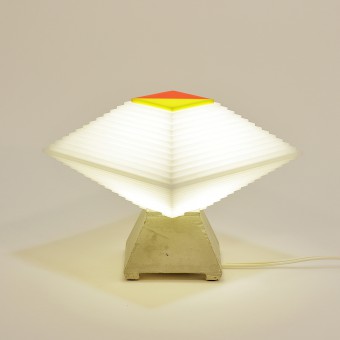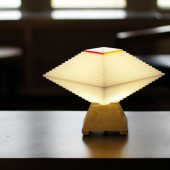
| THE AWARD |
| CATEGORIES |
| REGISTRATION |
| SUBMIT YOUR WORK |
| ENTRY INSTRUCTIONS |
| TERMS & CONDITIONS |
| PUBLICATIONS |
| DATES & FEES |
| METHODOLOGY |
| CONTACT |
| WINNERS |
| PRESS ROOM |
| GET INVOLVED |
| DESIGN PRIZE |
| DESIGN STORE |
| THE AWARD | JURY | CATEGORIES | REGISTRATION | PRESS | WINNERS | PUBLICATIONS | ENTRY INSTRUCTIONS |
Little Zig Table Lamp by Eve Fineman & Henri Preiss |
Home > Winners > Design #54112 >Interview |
 |
|
FS: What is the main principle, idea and inspiration behind your design?
EF: Our design was an interpretation of Henri Preiss' paintings, which are visually layered and complex. Due to the complexity of the work, we chose to zoom in on a detail that is a recurring motif in several of his pieces. There was a concept in Henri's work that we were interested in translating into functional objects, where the imagery is both foreign and familiar, ancient and futuristic. Henri's work also compresses 3-dimensionality onto a 2-dimensional plane, with a geometric intricacy that is spatially enigmatic. We enjoyed the challenge of then taking this imagery and creating a stable physical object, without losing the ethereal quality of the painting.
FS: What has been your main focus in designing this work? Especially what did you want to achieve?
EF: This lamp is one of a series, where we are taking a cropped portion of a painting and re-imagining it as lighting in a variety of different ways. For this specific piece, the Little Zig, our goal was to edit the piece down into its most essential elements, paying close attention to contrasting materiality.
FS: What are your future plans for this award winning design?
EF: We would like to continue to show this piece, and are interested in exploring possibilities for production and sales.
FS: How long did it take you to design this particular concept?
EF: The design of this concept came about over 2-3 months, and then we refined the design and built prototypes over the next few months.
FS: Why did you design this particular concept? Was this design commissioned or did you decide to pursuit an inspiration?
EF: Because so much of my work is client-driven, I make it a point to produce at least one piece a year that is speculative, based on a personal interest or investigation. The Zig lamp series falls into this category. Henri and I decided to work together, because we found our approach and interests to have many intersections, and we were curious to see where a collaborative project would take us. It seemed natural to pursue a collaboration together that would enrich both of our practices and allow us to learn and grow. While Henri was interested in delving deeper into design through the development of functional sculptures, I enjoyed the challenge of working with imagery that is much more complex, layered and colorfully rich than any of my own work.
FS: Is your design being produced or used by another company, or do you plan to sell or lease the production rights or do you intent to produce your work yourself?
EF: We are currently open to various possibilities, including selling or licensing the work, or self-producing.
FS: What made you design this particular type of work?
EF: Henri and I both wanted to work primarily with light as our medium; the dynamic quality of light was clearly fitting for translating the energy of his paintings into objects. Since it was necessary to simplify his work through the process of transforming it, using light enabled us to maintain the same level of intensity and dimension.
FS: Where there any other designs and/or designers that helped the influence the design of your work?
EF: I do not typically look at design projects when finding sources of inspiration for a piece. I tend instead to look outside of the specific area of design, and then synthesize my sources of inspiration into a functional design. In this case, Henri's paintings were the major influence over the outcome of the work. However, we have also both been photographing sculptural brutalist architecture on our travels over the past few years, and this has definitely become a stimulus in our current work. Specifically, our love of Carlo Scarpa's work was a big influence on this project.
FS: Who is the target customer for his design?
EF: This is a high-end table lamp, so it could be for an end-user, a restaurant group, a lighting manufacturer, distributer, or showroom.
FS: What sets this design apart from other similar or resembling concepts?
EF: The form and materials of this piece are unique in combination. The contrast of earth and cosmos give the Little Zig a particular identity.
FS: How did you come up with the name for this design? What does it mean?
EF: There are two meanings behind the name of this piece. 'Zig' is an abbreviated form of the word ziggurat, which refers to the form of the shade. It is an architectural form that still appears both ancient and modern, depending on the context. The series was also named Zig because of the passing of my stepfather, whom I nicknamed "Zig" when I was young. His passing coincided with the production of our first piece, and so the name serves to honor him as well.
FS: Which design tools did you use when you were working on this project?
EF: We worked using the following tools and processes: sketching, 3D printing, laser cutting, cardboard modeling, Sketchup, AutoCAD, Solidworks, and mold-making (for the concrete). We spent a lot of time experimenting with different concrete mixtures until we came to the right mix.
FS: What is the most unique aspect of your design?
EF: The most unique aspect of the design is the shade, because it is taken directly out of Henri's painting. It is because of this process that we can ensure that the piece is inimitable.
FS: Who did you collaborate with for this design? Did you work with people with technical / specialized skills?
EF: Henri and I designed and produced the prototype entirely in our studio. We had the help of student interns during the design and modeling phase.
FS: What is the role of technology in this particular design?
EF: Technology plays a big role in this piece. In addition to the small, multidirectional LED lamp used in the piece, the process of producing it relies upon digital fabrication technology. 3D modeling programs are used to generate the files for both the shade and the base mold, as well as the 3D printed scale models. By using these processes, we are able to essentially eliminate waste.
FS: Is your design influenced by data or analytical research in any way? What kind of research did you conduct for making this design?
EF: We did not use any data to determine this design. The process was driven entirely by artistic pursuits.
FS: What are some of the challenges you faced during the design/realization of your concept?
EF: Designing the process for production and assembly was the most challenging part. Embedded in the design process is not just figuring out how to put a piece together once, but determining how to best produce a piece so that it can be easily assembled by someone other than ourselves.
FS: How did you decide to submit your design to an international design competition?
EF: The Little Zig has had a very positive response since we completed it. It has already been in a couple of local exhibitions, as well as a show in Vancouver, so we decided it might be a good idea to see if we could gain further exposure in Europe and beyond.
FS: What did you learn or how did you improve yourself during the designing of this work?
EF: I learned that collaborating with an artist is a very different experience than working with other designers. Although they are related in many ways, art and design are two very distinct practices. Finding a common language was a wonderful way for me to grow as a designer.
FS: Any other things you would like to cover that have not been covered in these questions?
EF: Typically, my collaborations are a way to push myself outside of my comfort zone, so that I am forced to produce work that I would never have come up with on my own. This is an excellent way to grow and evolve as a designer.
FS: Thank you for providing us with this opportunity to interview you.
A' Design Award and Competitions grants rights to press members and bloggers to use parts of this interview. This interview is provided as it is; DesignPRWire and A' Design Award and Competitions cannot be held responsible for the answers given by participating designers.
| SOCIAL |
| + Add to Likes / Favorites | Send to My Email | Comment | View Press-Release |





